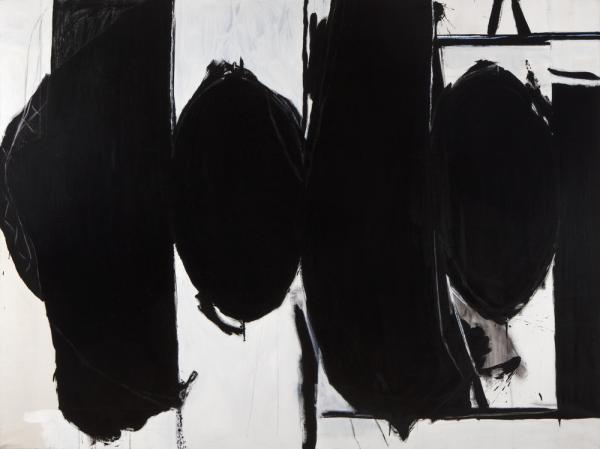Skip to main content
Elegy to the Spanish Republic
Artist
Robert Motherwell
(American, 1915 - 1991)
Datec. 1962/82
MediumMagna and acrylic on canvas
DimensionsUnframed: 72 x 96 1/4 x 1 in. (182.88 x 244.48 x 2.54 cm)
Framed: 73 1/2 x 97 3/4 x 1 3/4 in. (186.69 x 248.29 x 4.45 cm)
Framed: 73 1/2 x 97 3/4 x 1 3/4 in. (186.69 x 248.29 x 4.45 cm)
Credit LineCollection of the Modern Art Museum of Fort Worth, Museum purchase, The Friends of Art Endowment Fund
Object number1993.23
Status
Not on viewSignedrecto u.r.c. incised "R Motherwell"
Copyright© 2020 Dedalus Foundation, Inc. / Artists Rights Society (ARS), New York
Category
Label TextIn Robert Motherwell’s best-known series, Elegies to the Spanish Republic, which spanned from 1948 until his death in 1991, the artist explored the expressive contrasts of black and white and of vertical bars and ovoid shapes in close to two hundred paintings and in hundreds more drawings and prints. The Modern’s holdings from this series include three small studies and three paintings, including Elegy to the Spanish Republic, 1960. The works refer to the Spanish Civil War (1936–39) and what the artist saw as the tragic defeat of Spanish republicanism. He considered them not history paintings but memorials, a funeral lamentation for something that mattered. At the same time, he believed the works served as metaphors for the interrelation of life and death.
The Elegies began with an ink drawing Motherwell made in 1948 for a poem by Harold Rosenberg to be reproduced in a never-published issue of the journal Possibilities. He enlarged the drawing, reworked it in casein on board, and titled it At Five in the Afternoon after the refrain in Federico García Lorca’s poem “Lament for Ignacio Sánchez Mejías.” The economical composition of ovals and vertical bars of the initial sketches is recalled in Elegy to the Spanish Republic, an iconic example that captures the visual richness and emotional power of the Elegies. The painting also accommodates the recurrent interpretation of the black forms as phallic and testicular images, an interpretation that, although problematic, has become standard in literature on the series. Motherwell himself challenged this limited reading of his work, noting that resemblance was not the objective. Rather, he wished to communicate states of feeling by whatever means available, including light, color, weight, airiness, and strength.
The Elegies began with an ink drawing Motherwell made in 1948 for a poem by Harold Rosenberg to be reproduced in a never-published issue of the journal Possibilities. He enlarged the drawing, reworked it in casein on board, and titled it At Five in the Afternoon after the refrain in Federico García Lorca’s poem “Lament for Ignacio Sánchez Mejías.” The economical composition of ovals and vertical bars of the initial sketches is recalled in Elegy to the Spanish Republic, an iconic example that captures the visual richness and emotional power of the Elegies. The painting also accommodates the recurrent interpretation of the black forms as phallic and testicular images, an interpretation that, although problematic, has become standard in literature on the series. Motherwell himself challenged this limited reading of his work, noting that resemblance was not the objective. Rather, he wished to communicate states of feeling by whatever means available, including light, color, weight, airiness, and strength.











